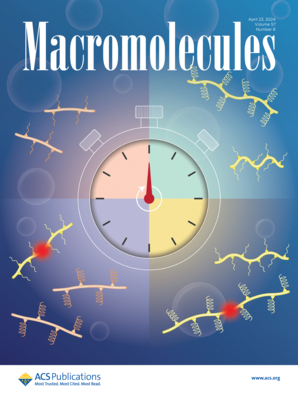Visualization and Characterization of Stress–Strain Behavior in Resin-Based Mechanoresponsive Sensors 3D-Printed Using Mechanochromic Cross-Linkers
IF 5.1
1区 化学
Q1 POLYMER SCIENCE
引用次数: 0
Abstract
This study explores the use of difluorenylsuccinonitrile-containing methacrylate (DFMA) as a mechanochromic cross-linker in a polymer system (N,N-dimethyl acrylamide, DMAA) for resin-based three-dimensional (3D) printing applications. The effect of the DFMA content on the mechanical properties and color response under mechanical stimulation was evaluated using tensile tests and color analysis. With the increase in the DFMA content, particularly when it reached 1.0 mol %, the tensile strength and mechanochromic intensity increase. DFMA incorporation also enabled the detection of localized polymer chain scission. Rheological analysis demonstrated that the DFMA–DMAA mixture exhibited a favorable photocuring behavior, making it suitable for liquid crystal display 3D printing. Moreover, the optimal 3D printing conditions were determined to minimize the dimension distortion of the printed specimens. A correlation between the red–green–blue (RGB) values and the stress–strain behavior was established based on the color analysis, providing a comprehensive understanding of the mechanochromic response of the material. These findings highlight the potential of P(DFMA–DMAA) for creating customizable, mechanochromic 3D-printed sensors with improved mechanical properties for various applications.

使用机械变色交联剂三维打印的树脂基机械响应传感器应力-应变行为的可视化与特性分析
本文章由计算机程序翻译,如有差异,请以英文原文为准。
求助全文
约1分钟内获得全文
求助全文
来源期刊

Macromolecules
工程技术-高分子科学
CiteScore
9.30
自引率
16.40%
发文量
942
审稿时长
2 months
期刊介绍:
Macromolecules publishes original, fundamental, and impactful research on all aspects of polymer science. Topics of interest include synthesis (e.g., controlled polymerizations, polymerization catalysis, post polymerization modification, new monomer structures and polymer architectures, and polymerization mechanisms/kinetics analysis); phase behavior, thermodynamics, dynamic, and ordering/disordering phenomena (e.g., self-assembly, gelation, crystallization, solution/melt/solid-state characteristics); structure and properties (e.g., mechanical and rheological properties, surface/interfacial characteristics, electronic and transport properties); new state of the art characterization (e.g., spectroscopy, scattering, microscopy, rheology), simulation (e.g., Monte Carlo, molecular dynamics, multi-scale/coarse-grained modeling), and theoretical methods. Renewable/sustainable polymers, polymer networks, responsive polymers, electro-, magneto- and opto-active macromolecules, inorganic polymers, charge-transporting polymers (ion-containing, semiconducting, and conducting), nanostructured polymers, and polymer composites are also of interest. Typical papers published in Macromolecules showcase important and innovative concepts, experimental methods/observations, and theoretical/computational approaches that demonstrate a fundamental advance in the understanding of polymers.
 求助内容:
求助内容: 应助结果提醒方式:
应助结果提醒方式:


